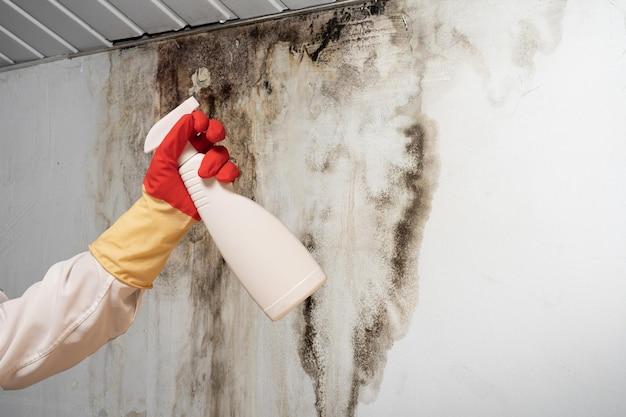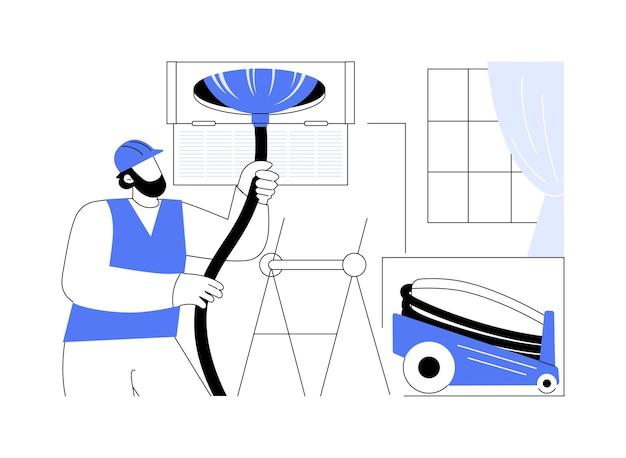Air ducts are an essential component of any HVAC system, ensuring the circulation of clean and fresh air throughout our homes. However, these ducts can become a breeding ground for mold if not properly maintained. Mold in air ducts can pose serious health risks and affect the quality of indoor air. In this blog post, we will explore the dangers of mold in air vents, discuss DIY techniques for mold removal, and answer common questions like whether mold can be cleaned out of ductwork. So, let’s dive in and learn how to tackle this pesky problem!
How to Banish Mold from Your Air Ducts
Starting the Mold Fight: A Battle with Mold in Your Air Ducts
So, you’ve discovered the presence of mold in your air ducts. Yikes! Not exactly the treasure you were hoping to find during your spring cleaning extravaganza. But fear not, mold conqueror! With a few handy tricks up your sleeve, you’ll be able to banish those pesky spores from your ducts and restore the pristine air quality of your home.
Step 1: Gear Up – The Mold Fighter’s Uniform
Before plunging into battle, make sure you’re equipped with the proper gear. Don your mold-fighting uniform, which, for your safety and amusement, includes protective clothing, gloves, goggles, and a trusty face mask. It’s important to protect yourself from the moldy army you’re about to face. Safety first, right?
Step 2: Mold Extermination 101
Now, let’s get down to business. Start by turning off the HVAC system to prevent the spread of mold spores throughout your place. Next, locate the culprit – your air ducts. Armed with a vacuum cleaner fitted with a HEPA filter, begin meticulously vacuuming each and every vent and duct opening. Remember, mold is a sneaky villain, so be sure to reach those hidden corners and crevices.
Step 3: Call in Reinforcements – The Mold-Busters
Sometimes, those mold colonies are just too resilient to face alone. In such cases, it’s time to bring in the big guns – professional mold remediators. These seasoned experts have the skills, experience, and fancy equipment to obliterate mold from your air ducts. They’ll thoroughly inspect, clean, and treat your ducts, ensuring that no spore is left behind. Plus, they’ll do all the dirty work while you can sit back, relax, and flaunt your mold-fighting prowess.
Step 4: The Prevention Game – Keeping Mold at Bay
Congratulations, mold warrior! You have successfully defeated the mold army in your air ducts. But the battle doesn’t end here. To prevent future mold invasions, you need to be proactive. Regularly inspect your ducts for any signs of moisture, as this is mold’s best friend. Ensure proper ventilation, fix any leaks promptly, and maintain a healthy humidity level in your home. By staying vigilant, you can keep those pesky mold spores from ever gaining a foothold in your ducts again.
Now that you’re armed with these mold-fighting strategies, go forth and conquer those duct invaders! Your home will thank you with fresher, cleaner air, and you can proudly call yourself the mold master of the neighborhood. Happy mold hunting!
HVAC Mold Inhibitor: Say Goodbye to Mold in Your Air Ducts!
What is an HVAC Mold Inhibitor
An HVAC mold inhibitor is like a superhero for your air ducts, fighting off mold and ensuring clean and fresh air circulation in your home. It’s a magical potion (well, not really magical) that prevents mold or mildew growth in your HVAC system by inhibiting their spores from settling and multiplying.
How Does it Work
Think of the HVAC mold inhibitor as an invisible force field against mold. It’s like spraying a superhero cape over your ducts, protecting them from the villainous mold spores. The inhibitor contains special ingredients that attack the root cause of mold growth. Once applied, it forms a protective barrier, making it difficult for mold spores to latch onto surfaces and reproduce.
Benefits of Using an HVAC Mold Inhibitor
- Bye-Bye Mold: With an HVAC mold inhibitor, you can bid farewell to that gross, musty smell and unsightly patches of mold growth in your air ducts. Say hello to fresh, clean air!
- Improved Air Quality: Mold not only looks and smells bad, but it can also worsen allergies and respiratory issues. Preventing mold growth in your HVAC system helps maintain excellent indoor air quality.
- Increased Energy Efficiency: When mold accumulates in your air ducts, it obstructs airflow, making your HVAC system work harder to maintain the desired temperature. By inhibiting mold, your system can operate more efficiently, saving energy and reducing utility bills.
- Long-Term Protection: An HVAC mold inhibitor provides long-lasting protection, keeping your air ducts mold-free for an extended period. You won’t have to worry about constant cleaning or mold remediation.
How to Choose the Right HVAC Mold Inhibitor
When searching for an HVAC mold inhibitor, be sure to consider the following factors:
– Effectiveness: Look for a product with proven effectiveness in preventing and inhibiting mold growth.
– Safety: Ensure the product is safe for use in your HVAC system without causing any harm to you, your family, or the environment.
– Compatibility: Check whether the inhibitor is compatible with your specific HVAC system to guarantee optimal performance.
– Easy Application: Find an inhibitor that is easy to use and can be applied without professional assistance, saving you time and money.
Don’t let mold ruin your indoor air quality or compromise your health. An HVAC mold inhibitor is a fantastic solution for keeping your air ducts mold-free and your home fresh and clean. Say goodbye to mold and hello to a healthier, happier home with this superhero of air duct care!
Is Mold in Air Vents Harmful
Understanding the Silent Menace Lurking in Your Ducts
So, you’re chilling on your couch, binge-watching your favorite TV series, when suddenly you start to feel a tickle in your throat. You cough once, twice, and before you know it, you’re in a full-blown coughing fit that could rival a walrus.
Before you panic and start questioning your life choices, let’s talk about the silent menace that might be causing your coughing marathon – mold in your air vents. Yes, my friend, it’s time to delve into the captivating world of mold and find out if it’s harmful or just a pesky little troublemaker.
The Mold Drama: Debunking the Myth
Picture this: mold is the diva of the microscopic world. It loves to make an entrance and steal the show. But does it actually pose a threat to your health? Well, thankfully, mold isn’t known for its lethal tendencies. Phew!
While mold can trigger allergies and exacerbate respiratory conditions like asthma, it’s not usually a direct cause for concern. Unless you’re living with a super-sensitive individual or have a house that doubles as a botanical garden, you’re unlikely to experience any major health issues.
The Real Culprit: The People Unlucky Enough to Be Affected
Now, let’s talk about who’s really in danger here. Spoiler alert: it’s not you, my fearless reader! It’s those unlucky souls who happen to have a heightened sensitivity to mold. You know, those friends who sneeze at the mere thought of pollen? Yeah, they’re the ones we’re talking about.
For people with mold allergies or compromised immune systems, the presence of mold in air vents can turn their lives into an endless battle with congestion, itchy eyes, sneezing, and other delightful symptoms. So, if you’re living with such a person, it’s time to channel your inner superhero and tackle that mold head-on.
Air Duct Mold: A Cautionary Tale
Now, before you whip out your imaginary cape and rush to save the day, it’s important to know that mold in air vents can spread like gossip at a high school reunion. Don’t believe me? Just imagine your air ducts acting as secret passageways for mold spores, allowing them to infiltrate every nook and cranny of your home. It’s a mold invasion!
If left unchecked, this moldy party can cause a lot of trouble. Not only can it lead to expensive property damage, but it can also impact the quality of the air you breathe. And let’s face it, no one wants to breathe air that smells like a damp basement in the middle of a forest. Yuck!
Wrapping Up the Moldy Mystery
So, to answer the burning question, yes, mold in air vents can be harmful. Not to you, my fearless friend, but to those with mold allergies and weakened immune systems. And let’s not forget about the potential property damage and the funky smell that can take over your humble abode.
If you’re ready to put on that imaginary cape and rid your air vents of mold, check out our next subsection, where we’ll dive into the exciting world of mold removal techniques. Get ready to kick some moldy butt, superhero style!
DIY Mold Removal from Air Ducts
Identifying the Mold Menace
Before we jump into the fun world of DIY mold removal, let’s take a moment to identify the pesky culprit lurking in your air ducts. Mold is like that annoying friend who shows up uninvited and overstays their welcome. It thrives in damp and dark spaces, just like that mysterious stain on your favorite shirt. So, if you’re sniffing a musty odor or noticing weird discoloration around your vents, congrats! You’ve got some unwelcome guests in your air ducts.
Breathe In, Breathe Out
Now that we’ve established the mold invasion, take a moment to inhale deeply and release any potential panic. You’ve got this! DIY mold removal might sound daunting at first, but fear not, for we shall navigate this path together, armed with knowledge and a sprinkle of humor.
Gather Your Weaponry
To effectively combat mold, you’ll need some essential tools and materials. Don’t worry; it’s nothing crazy like swords or magic potions. Here’s what you’ll need:
1. Protective Gear:
Imagine yourself as a mold superhero, complete with goggles, gloves, and a mask. It’s not the trendiest look, but hey, fashion can wait when mold is involved.
2. Cleaning Solutions:
Time to unleash the cleaning arsenal! Choose your weapon – either a commercial mold cleaner or a DIY solution made with vinegar, baking soda, and water. It’s like a science experiment, but with cleaner air ducts as the prize.
The Great Mold Hunt
Now that you’re fully armored and equipped, it’s time to track down those mold colonies like a seasoned detective. Grab a flashlight, put on your detective hat, and explore your air ducts. Look for any signs of mold growth – dark spots, fuzzy textures, or anything that looks suspiciously like alien life forms.
Elimination Station
Once you’ve pinpointed the moldy villains, it’s time for some hardcore removal action! Here’s our secret DIY mold removal recipe:
Step 1: Attack Mode
Grab your trusty cleaning solution and apply it generously to the affected areas. Let it work its magic, like a knight slaying the mold dragon. Give it some time to loosen up the mold and make your job easier.
Step 2: Brush Battle
Equip yourself with a stiff-bristled brush and scrub away! Be thorough, yet gentle – you don’t want to damage your air ducts. Think of it as a spa day for your ducts, just without the soothing music and cucumber slices.
Preventing Future Mold Shenanigans
Congratulations, brave mold remover; you have successfully defeated the mold army! But remember, prevention is key to keeping those sneaky spores at bay. Here’s a mini checklist to keep your air ducts spick and span:
– Monitor humidity levels in your home and decrease them if necessary.
– Fix any leaks or water damage promptly, like a superhero on a mission.
– Keep your air filters clean and replace them regularly. They deserve some love too!
Now that you’re armed with knowledge and armed with cleaning supplies, go forth and conquer those moldy air ducts! DIY mold removal may seem like a daunting task, but with a touch of humor and a sprinkle of perseverance, you’ll have clean and fresh air flowing through your home in no time. So bid farewell to the mold menace and let your air ducts breathe easy once again.
How to Check for Mold in AC Ducts
1. Be a Mold Detective
You don’t need a magnifying glass or a Sherlock Holmes hat to check for mold in your AC ducts. Just use your senses! Start by sniffing around your house. If you catch a whiff of something funky every time the air conditioner kicks in, it might be a sign of mold. Mold has a distinct musty odor that likes to linger in the air. So, follow your nose and let your “moldar” instincts guide you.
2. Put on your CSI Gloves
Now that you’ve got your detective hat on, it’s time to roll up your sleeves and get hands-on. First, turn off your AC system. Nobody wants to battle mold in a gust of freezing air. Next, grab a flashlight, a mirror, or even a selfie stick if you’re feeling fancy. Shine the light into your ducts and take a peek. Is there a suspicious buildup of dark, fuzzy substances? If so, it’s like finding mold’s secret stash!
3. Play Hide-and-Seek with Mold
Mold loves to hide in dark and damp places. So, grab your flashlight (or selfie stick) again and start inspecting the nooks and crannies of your AC ducts. Shine the light deep into those hidden corners and see if mold appears, like a game of peek-a-boo. In particular, pay special attention to any areas where condensation or moisture is more likely to occur. Mold loves to make itself at home in those cozy spots.
4. Beware of Mold’s Disguise
Mold is a sneaky little bugger. It can hide behind walls, inside insulation, or even within the inner layers of your ductwork. So, even if you can’t see any mold, it doesn’t mean it isn’t there. If you suspect mold but can’t find any visible signs, it might be best to call in some professional help. After all, mold can be a bit of a chameleon, and dealing with it requires expert skills.
5. Don’t Ignore the Warning Signs
Mold in your AC ducts isn’t just a minor inconvenience—it can have serious health implications. If you or your family members are experiencing unexplained allergies, coughing, or respiratory issues, mold could be the culprit. Take these symptoms seriously and don’t ignore the warning signs. It’s always better to be safe than sorry, so if you suspect mold, take action and get rid of it ASAP. Your lungs will thank you!
Now that you’ve learned how to channel your inner mold detective, go forth and conquer those sneaky spores in your AC ducts! Remember, prevention is key, so ensure your ducts stay clean and cozy for the long haul. Happy mold-busting!
Can You Really Get Rid of Mold in Your Air Ducts
So, you’ve discovered a mold party happening in your air ducts, and you’re wondering if it’s possible to kick those uninvited guests out for good. Well, my friend, I’m here to tell you that you’re not alone in this battle against the slimy invaders!
The Mold Dilemma: To Clean or Not to Clean
First and foremost, let’s address the burning question on your mind: can mold be cleaned out of ductwork? The short answer is yes, it’s possible. But hold your horses before you reach for that trusty feather duster and start playing superhero.
Hire the Pros to Bust the Mold
When it comes to dealing with mold in your air ducts, it’s generally best to wave the white flag and call in some professionals. HVAC technicians who specialize in duct cleaning are like mold-whisperers, armed with specialized equipment and knowledge to tackle this hairy situation. They’ll zap your ducts with UV lights, blast away the mold with high-powered vacuums, and leave your ducts feeling fresher than a daisy in spring.
DIY: Ducts It Yourself… Maybe
Now, if hiring a pro feels a bit too serious for your mold-infested soul, you might be tempted to tackle the task yourself. But be warned, my friend, this path is not for the faint-hearted nor the inexperienced. DIY duct cleaning requires a certain level of expertise, and if you’re not careful, you might end up with a bigger mess than before.
Prevention Is the Best Medicine
But let’s step back for a moment and talk about the best way to deal with mold in your air ducts: prevention. Yes, my friend, the best defense is a good offense. To keep those mold spores at bay, ensure proper ventilation, control your home’s moisture levels, and stay on top of regular air duct maintenance. Because let’s be real, prevention may not be as exciting as a full-on duct cleaning showdown, but it’s the way to go if you want those ducts to stay mold-free.
In conclusion, while it’s possible to clean mold out of your air ducts, it’s often best to leave it to the professionals. Unless you’re a DIY master with ample experience, prevention is key to avoiding moldy surprises in the future. So, sit back, relax, and let the experts do their magic. Your ducts will thank you, and your nose will too.



